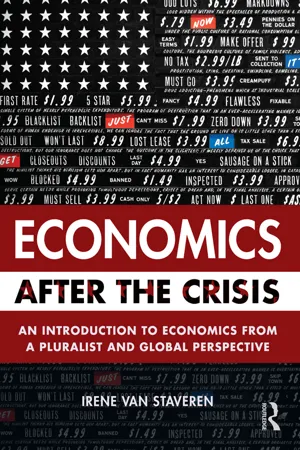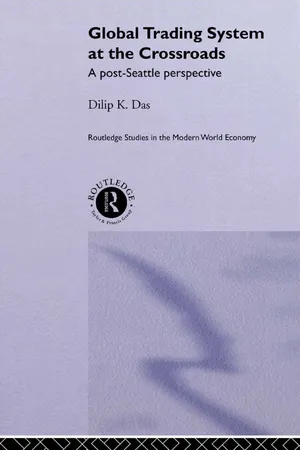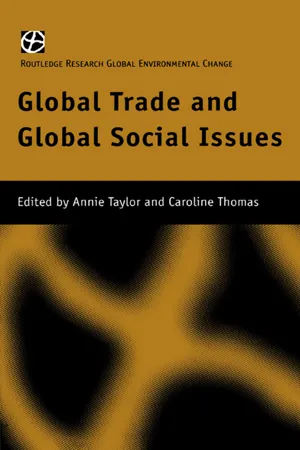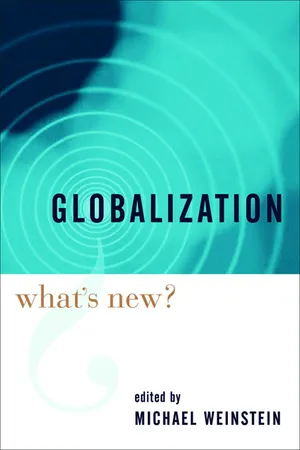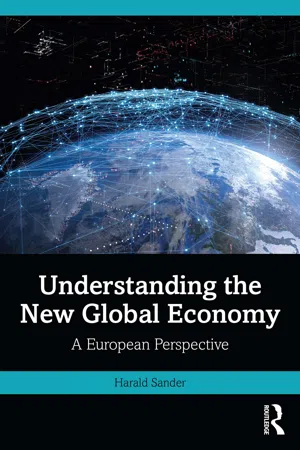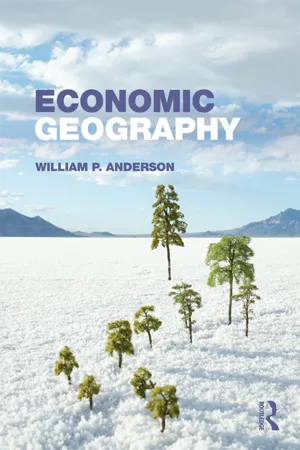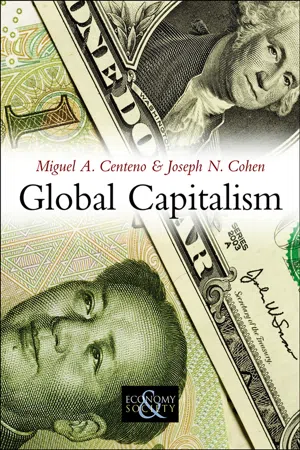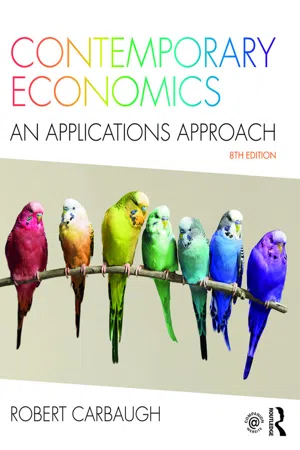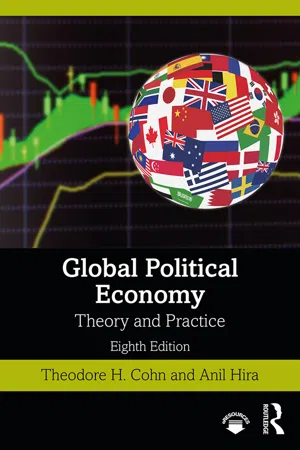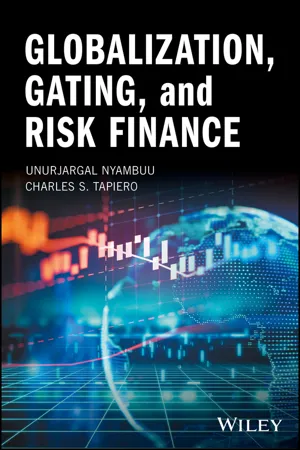Economics
Global Trade
Global trade refers to the exchange of goods and services between countries across international borders. It allows nations to specialize in producing goods where they have a comparative advantage and to access a wider variety of products. Global trade is facilitated by international agreements, trade policies, and organizations such as the World Trade Organization.
Written by Perlego with AI-assistance
Related key terms
10 Key excerpts on "Global Trade"
- eBook - ePub
Economics After the Crisis
An Introduction to Economics from a Pluralist and Global Perspective
- Irene van Staveren(Author)
- 2014(Publication Date)
- Routledge(Publisher)
14International trade14.1 Introduction
14.1.1 Globalisation and trade
Globalisation is the process through which the world becomes increasingly interconnected through the international expansion of markets. This happens along four axes:- International trade in goods and services: imports and exports;
- International capital flows with foreign direct investments and portfolio investments;
- International labour migration, for example within trade unions such as the European Union or through undocumented migrant workers without official residence permits;
- Internationalisation of production processes in global value chains through the production facilities of multinational companies and subcontracting (outsourcing).
In our globalised world, these four axes are closely inter-related in global production networks producing for global value chains. Global value chains (GVCs) are the globally organised production activities for a final good driven by a lead firm. They organise production either through foreign subsidiaries of a single multinational company, or through outsourcing production activities to a variety of foreign firms. Lead firms in global value chains, often a well-known consumer brand such as Wall-Mart, IKEA, or Mitsubishi, break up their activities across the globe, sourcing inputs and organising production activities from a large number of low-cost suppliers. Some lead firms, such as Nike, are even ‘fab-less firms’: they are manufacturers without factories for fabrication (fab). Approximately 50 per cent of Global Trade occurs within multinational companies (MNCs).International trade is key to globalisation. Trade is the international exchange of goods and services. It is the opposite of autarky, when a country is self-sufficient and produces everything that it consumes. Trade makes sense when it provides benefits as compared to autarky. These are called the gains from trade - eBook - ePub
- Dilip K. Das(Author)
- 2001(Publication Date)
- Routledge(Publisher)
1 Global trading system Contemporary scenario Hope is a thing with feathers, That perches in the soul. Emily Dickinson 1.1 The new global trading system Although imprecisely defined, economic globalization has almost become a catch phrase at the end of the twentieth century, and for good reason. Globalization is a multifaceted phenomenon. It covers a range of trends in economic, finance, technology, business, and international relations, which may be mutually reinforcing but which have diverse origins. As conventionally understood, international trade and capital flows are central to the globalization process. Although capital flows are important in their own right, trade in goods and services has captured a great deal of attention. Along with rapid technological developments—especially in information and communication technologies, telecommunications, and transport—international trade has been a significant driving force behind globalization. Trade has contributed to the enormous benefits that have flowed from mutual interdependence among nations and from integration of the global economy. The objective of this opening chapter is to introduce the reader to the World Trade Organization (WTO) 1 and recent transformations in the global trading system. Over the last half-century a great deal of liberalization has taken place in both developing and industrial economies, albeit the process moved at an uneven pace. This chapter analyzes its welfare effects—including effects on poverty—over different countries and country groups. Despite its salutary economic effects, trade liberalization and the opening up of economies have always been an onerous process. We analyze here the how and why of this seeming irrationality. Employment-related decisions make this process of opening up even more difficult to handle for the policy makers. In addition, not all developing economies benefit from liberalization - eBook - ePub
- Annie Taylor, Caroline Thomas(Authors)
- 2005(Publication Date)
- Routledge(Publisher)
1 TRADE IN CONTEXT Approaches to globalizationSimon EagleIntroductionGlobalization is increasingly heralded as an important new development in economic, social, cultural and political life. Anthony Giddens has even made the claim that it is ‘a concept which deserves a central place in the lexicon of the social sciences’ (Giddens 1990: 51). Recent transformations in the international political economy have contributed to the current vogue for globalization. It is common for a whole host of developments and innovations in the world economy to be grouped under the rubric of the globalization of finance and production. Trade is arguably the driving force in this new globalized economy. In part this is due to the differentiation of production processes which results in manufacturing systems being functionally integrated across different areas of the world economy. The importance of trade in this changing world system is also underlined by the fierce competition to drive down costs, and therefore prices, through sales abroad. This chapter argues that, in order to understand the nature and implications of changes to the trade system and the world economy more generally, it is important to go beyond the orthodox debate over globalization and to focus on the phenomenon of international capital and the social forces associated with it.What may be termed the orthodox debate over globalization has important implications for how we understand the emerging trade system. This chapter focuses upon two influential and competing contributions to this orthodox debate. The first part of the chapter considers the position of the economist Ohmae. The second section examines the position of Hirst and Thompson. The third section, through a critical assessment of these positions, establishes some of the limitations of the orthodox debate over globalization. The fourth part of the chapter outlines some implications for our understanding of the changing world trade system, including the need to consider qualitative as well as quantitative indicators of changes in the international economy. - eBook - ePub
Globalization
Education Research, Change and Reform
- Zygmunt Bauman, Michael Weinstein, Nicholas Sun-keung Pang(Authors)
- 2005(Publication Date)
- Columbia University Press(Publisher)
2 Trade and Globalization DOUGLAS A. IRWIN T HE PAST QUARTER CENTURY has witnessed a rapid expansion of world trade, with international commerce now touching nearly every corner of the globe. This expansion of trade—along with increased capital flows, travel, migration, and other contacts between countries—is one of the most pronounced and significant features of the phenomenon known as globalization. The increasing importance of international trade is strikingly illustrated in the case of the United States. At one time, international trade was a relatively unimportant element of the U.S. economy, with its large domestic market and internal free trade. Today, the situation is dramatically different: the United States imports toys from China, clothing from Costa Rica, and steel from Germany; it exports aircraft from Washington, wheat from Kansas, and machinery from Illinois. Hardly a sector of the economy or a region of the country remains unaffected by international markets, some for better and some for worse. No wonder the rapid growth of trade has triggered an intense debate over its impact on the U.S. economy and over the future direction of U.S. trade policy. In this chapter, I’ll set out the basic facts regarding the changes in international trade over the past few decades, with particular focus on the United States. Then I’ll consider various explanations for the expansion of trade. Finally, I’ll briefly discuss why the trade-related aspects of globalization have triggered such controversy, as exemplified by popular protests against the World Trade Organization (WTO). T HE G ROWTH IN T RADE Figure 2.1 provides a dramatic illustration of the growth in world trade over the past decade and a half. Since World War II, the volume of world trade in merchandise goods has expanded more rapidly than global production of such goods. But since the mid-1980s, the relative growth in trade has accelerated sharply - eBook - ePub
Understanding the New Global Economy
A European Perspective
- Harald Sander(Author)
- 2021(Publication Date)
- Routledge(Publisher)
3Global Trade
DOI: 10.4324/9781003057611-3Cross-border trade has been growing faster than global production since 1870, leading to the present record level of trade integration, as measured by the increase in the trade-to-GDP ratio (Figure 3.1 ). There are, however, two notable interruptions: the inter-war period of de-globalisation and the cease of the trade integration process since the great financial crisis (GFC) of 2008–2009. Is the latter only a temporary standstill or are we entering the phase of a ‘new normal’? This chapter explores the key features of today’s trade, with a focus on global value chain trade, through the lens of modern trade theories. It highlights the implication of Global Trade for income (in-) equality across and within nation states, and the role of contemporary trade policies to deal with the upcoming challenges emanating from global competition, new technologies, and climate change.FIGURE 3.1World Trade as a Share of World GDP (in %), 1870–2019.Sources: 1870–1969 data are from Ourworldindata.org based on Klasing and Milionis (2014 ) for 1870–1949 data and Penn World Tables (8.1) for 1950–1969. The 1970–2019 data is retrieved from World Bank, World Development Indicators.Note: Trade is measured as the sum of export and imports of goods and services.1 Trade globalisation and trade costs
The key to understanding trade globalisation are trade costs in the broadest sense. Not just transportation costs, but everything that makes trading across borders more expensive or cheaper, e.g. trade barriers like tariffs, but also communication costs. Hence, technologies and trade policies are major drivers of globalisation. Interpreting the history of trade globalisation as the outcome of the interaction of technological developments and policies, allows to distinctly identify three waves of globalisation, as introduced in Chapter 1 - eBook - ePub
- William P. Anderson(Author)
- 2012(Publication Date)
- Routledge(Publisher)
1 Our objective here is more modest. Essentially, the next three chapters address the following question: how does the transition to a global knowledge economy affect the principles of economic geography as set forth in the first five sections of this book? Some observers argue that globalization and the proliferation of information and communications technology means that space is becoming irrelevant, distance is disappearing, so economic geography as we know it is out the window. But the fact that distance is getting easier to overcome does not mean it no longer matters. As we have already seen, reductions in the friction of distance lead to predictable changes such as increased scale of production and more spatial interaction. Perhaps most importantly, cheaper transportation and better communication make it easier for firms to exploit spatial differentiation at a global scale.These issues will be addressed in detail later, but at the outset some basic definitions are needed. The term “globalization” seems to have as many definitions as there are books and articles written about it. For the moment, let’s settle for a very simple definition of globalization as the integration of economic activity at a global scale. Of course, this begs the question: what do we mean by integration? International trade and foreign direct investment are both forms of economic integration that can be measured in terms of flows of goods or funds between nations. In these cases, production is still conducted within national borders. At a deeper level of integration, the production process itself involves tasks performed by different actors at different locations around the globe who are closely coordinated via information and communications networks. As we will see, people from a dozen or more countries may have been involved in the design, production, distribution and marketing of the shirt you are wearing right now. It is this more complex type of integration that most people have in mind when they speak of globalization. To make this distinction clear, we will use the term internationalization to refer to integration across national borders that involves goods that are produced in a single country but sold in to an international market. Internationalization is not distinct from globalization; rather, it is a limited form of globalization.The knowledge economy is not quite so easily defined. A precise definition, including an explanation of the distinction between information and knowledge, is deferred until chapter 26 - eBook - ePub
Global Capitalism
A Sociological Perspective
- Miguel A. Centeno, Joseph N. Cohen(Authors)
- 2013(Publication Date)
- Polity(Publisher)
5 But they also are a product of the walls established within the leading economic blocs, which discourage imports from the bottom 150 economies. Europe and North America imported a total of less than $5 billion of agricultural goods from the least developed countries in 2006 and a little over $18 billion of manufactures (almost exclusively low-tech) for a total of less than half a percentage point of their imports. These walls consist of a variety of bricks, including tariffs, content regulations, and domestic subsidies. The most significant obstacle remains the limits on legal global movements of labor, which limits the developmental benefits of the one resource in which the poor have a clear comparative advantage. As the LDCs have pointed out in round after round of talks, the rich countries are in favor of free trade as long as their domestic constituents do not have to suffer the consequences. Consistently, the richer countries have failed to commit themselves to opening markets and have frustrated efforts to create any kind of differential treatment for poorer countries within the Global Trade agenda.Global Trade is therefore not a simple exchange of comparative advantages between equals. Rather, the global system is made of hierarchies and these in turn reflect both historical legacies and political realities. Patterns of trade still reflect relations established over a century ago and the flows of goods are certainly in part determined by political choices on tariffs and the like. The Global Trade system exists inside a historical and geopolitical context.Dependency and InteractionOne important aspect of the globalization of production and consumption is that economic autarchy is no longer possible. If an economy participates in the global market it is, in a sense, also hostage to it. This is a perfect example of the kind of complexity discussed earlier: a society’s economic well-being may be affected by decisions, and political or physical events which no one could predict, much less control.Perceptions of this dependence are quite varied. The most optimistic reading harkens back to the first appearance of capitalism, through notions of Kantian peace, and hopes that globalization will make us all “too busy to hate” (Friedman 2005). A less sanguine perspective approaches this integration from what we may call a realist perspective (Keohane 1984). Such a view retains national interests at the center and asks how this interdependence and integration will weaken or strengthen these. A third perspective does something similar, but from the specific view of the developing world. “Dependency theory” suggests that global economic interactions invariably benefit the already rich and distort the economies of the still poor (Cardoso and Faletto 1979). Finally, “world systems” theory returns us to a global level (Arrighi 1994). Some within this perspective argue that the entire system is developed in order to benefit a new “global capitalist class” and their organizational representatives. - No longer available |Learn more
Contemporary Economics
An Applications Approach
- Robert Carbaugh(Author)
- 2016(Publication Date)
- Routledge(Publisher)
In recent decades, the U.S. economy has become increasingly integrated into the world economy—that is, it has become an open economy. This integration has involved trade in goods and services, financial markets, the labor force, ownership of production facilities, and dependence on imported materials.As a rough measure of the importance of international trade in a nation’s economy, we can look at the nation’s exports plus imports as a percentage of its gross domestic product (GDP). In 2015, the United States exported about 11 percent of its GDP, while imports were about 14 percent of GDP; the U.S. economy’s openness to trade thus equaled 25 percent. The relative importance of international trade in the U.S. economy has increased by about 50 percent during the past century.The United States exports a variety of goods, including grain, chemicals, scientific equipment, machinery, automobiles, computers, and commercial aircraft. It also imports many goods such as steel, oil, automobiles, textiles, shoes, rubber, and foodstuffs such as bananas, tea, and coffee. The United States’ biggest trade partners are Canada, Japan, Mexico, and China. Other leading trading partners include Germany, the United Kingdom, South Korea, Singapore, Belgium, and Luxembourg.The significance of international trade for the U.S. economy is even more apparent when we consider certain products. For example, we would have no chrome bumpers for automobiles if we did not import chromium, no tin cans without imported tin, and fewer personal computers without imported components such as memory chips. Students taking a 9:00 A.M. course in economic principles might doze off if we did not import tea and coffee. Moreover, many of the goods that we purchase from foreigners would be much more expensive if we depended on American production. Table 16.1 provides examples of fruits that the United States imports.The Advantages Of Specialization And Trade
The notion of being self-sufficient may be appealing. You might even desire to live by yourself in an isolated area such as northern Montana or Alaska. However, living on your own would mean you could only consume the goods that you produce. The food that you eat, the clothing that you sew, and the house that you build would be nothing like the goods that you are currently able to buy. You would not be able to obtain many products, such as cell phones, DVD players, medicines, and automobiles. Because of the constraints of self-sufficiency, most people prefer to specialize and trade with others. - eBook - ePub
Global Political Economy
Theory and Practice
- Theodore H. Cohn, Anil Hira(Authors)
- 2020(Publication Date)
- Routledge(Publisher)
Chapter8Global Trade Relations
T rade relations have aroused strong positive and negative emotions from the earliest times. Whereas proposals linking free trade with world peace can be traced back to the seventeenth century, trade conflicts have been common since the Middle Ages. The conflicts are often limited in scope, but sometimes escalate and become “trade wars.”1 Societal groups often have strongly-held views about trade. For example, internationalist firms that depend on exports, imports, and multinational production pressure for trade liberalization agreements; but domestically-oriented firms threatened by import competition may oppose these agreements.2 Trade is a contentious issue because interest groups and the broader public view their welfare as being more affected by trade policy than by monetary, investment, or financial policy. Thus, business, labor, agricultural, consumer, environmental, and cultural groups try to influence government trade policies.The forces of globalization have had a major effect on trade relations. From 1950 to 1973, world economic output (or GDP) grew at an average annual rate of 5.1 percent while trade increased on average by 8.2 percent. From 1980 to 2011, world trade grew on average almost twice as fast as world economic output.3 The 2008 global financial crisis precipitated “drops in global production and trade, first in the developed economies and then in developing countries.”4 However, the rise of trade protectionism in response to the 2008 crisis was quite muted, and not at all comparable to the protectionist surge in response to the Great Depression of the 1930s.5 In the 1930s there was no Global Trade organization, whereas today we have the World Trade Organization (WTO) and a large number of preferential trade agreements (PTAs) that help to stabilize trading relations. Furthermore, multinational corporations (MNCs) today have a strong vested interest in trade liberalization, and intrafirm trade within MNCs accounts for about one-third of total world trade. As a former WTO director-general stated, “businesses now trade to invest and invest to trade—to the point where both activities are increasingly part of a single strategy to deliver products across borders.”6 - eBook - ePub
- Unurjargal Nyambuu, Charles S. Tapiero(Authors)
- 2017(Publication Date)
- Wiley(Publisher)
Using their data we illustrate the historical trend in this overall index for selected countries as well as its sub‐indexes, including tariff, regulatory trade barriers (non‐tariff and compliance cost of trade), and capital and people movement control in Figure 9.4. These indexes also show the fall in the ratings (since early 2000), which can be explained in terms of increased non‐tariff trade barriers 6 and growth of regulations on businesses and investments (especially in the USA). Figure 9.4 Indexes on international trade freedom, tariff and regulatory trade barriers, and control on capital and people movements. Source: Data from The Economic Freedom of the World: 2015 Annual Report by Gwartney et al. 2015. From national and political points of view, trade and globalization have in some countries contributed to an awareness that global and free markets may be “double‐edged”: for one increasing exports, the other decreasing imports; for one increasing employment, the other may also be losing jobs; for greater global wealth, greater social and economic inequalities may ensue. Further, in a globalized world, with greater and homogeneous industrial and technological capacities, increasingly competitive exchanges and gated economies may have altered the fundamental and conventional assumptions that have defined open economies and free trade as well as their contribution to the national common good. In such an environment, economics and finance are increasingly assessed from social and political perspectives: trade, economic specialization, global industrial services, and technology‐intensive and in (some cases stealth) financial services. These are both challenging with new opportunities and new risks. These issues are attended to below based on simple models to highlight the intricate complexity that Global Trade and globalization are confronted by
Index pages curate the most relevant extracts from our library of academic textbooks. They’ve been created using an in-house natural language model (NLM), each adding context and meaning to key research topics.
